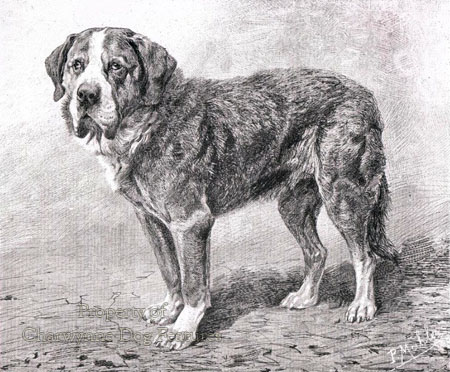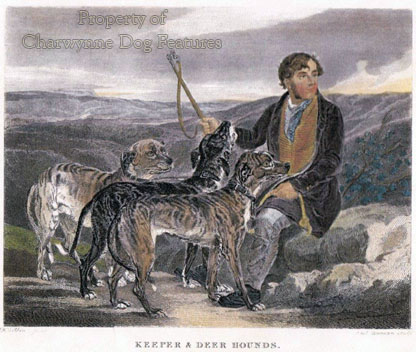314 Respecting Heavy Hounds
THE MASTIFFS: THE HEAVY HOUNDS
by David Hancock

 "A mastiff is a manner of hound." (from 'The Master of Game' by Edward, second Duke of York, 1410)
"A mastiff is a manner of hound." (from 'The Master of Game' by Edward, second Duke of York, 1410)
The hound group, as recognised by the Kennel Club of England, embraces a distinguished and extremely varied collection of breeds of dog. The scenthounds are well represented, from the solemn Bloodhound to the rascally Beagle, with more foreign breeds like the Basset Fauve de Bretagne, the Petit Basset Griffon Vendeen and the Hamiltonstovare, entering the list with each decade. The sighthounds also feature strongly, from the aristocratic Afghan Hound to the once humble Whippet. The group even includes a breed which works to the gun, the Finnish Spitz, and a breed better classified as a terrier, the Dachshund. But there is a serious omission in this group, that of the heavy hounds, sometimes called the hunting mastiffs.
 The omission of the Great Dane, once a renowned boarhound, from the Hound Group has long been not just a significant loss from the group but also a threat to the credibility of the group system itself. That omission is however much more understandable when related to the omission of the hunting mastiffs altogether. Why should wolfhounds feature in this group but not boarhounds and the heavy hounds once used to hunt other big game, such as wild bulls, buffalo, bears and even wild asses? I suspect that one reason is the influence which Victorian writers on dogs had on the emerging Kennel Club. The former offer us fascinating reading material and provide quaint quotes but their scholarship, particularly any objective corroborated research, is sadly lacking. Regrettably, such sources are always the first resort of the eager breed historian or the overnight dog expert. A fair general summary might be that the Victorian writers on dogs were all too often gundog enthusiasts only too willing to portray other breeds in their contemporary rather than their historic setting.
The omission of the Great Dane, once a renowned boarhound, from the Hound Group has long been not just a significant loss from the group but also a threat to the credibility of the group system itself. That omission is however much more understandable when related to the omission of the hunting mastiffs altogether. Why should wolfhounds feature in this group but not boarhounds and the heavy hounds once used to hunt other big game, such as wild bulls, buffalo, bears and even wild asses? I suspect that one reason is the influence which Victorian writers on dogs had on the emerging Kennel Club. The former offer us fascinating reading material and provide quaint quotes but their scholarship, particularly any objective corroborated research, is sadly lacking. Regrettably, such sources are always the first resort of the eager breed historian or the overnight dog expert. A fair general summary might be that the Victorian writers on dogs were all too often gundog enthusiasts only too willing to portray other breeds in their contemporary rather than their historic setting. - Copy.jpg)
From such a background, the mastiff type became embraced by the Working Group and a breed like the Bulldog, so much a sporting dog in previous centuries, became a Utility Group breed, a description even sounding disparaging. Small wonder that this splendid breed developed more and more into an unathletic exaggeration of its former sporting self. We may thankfully not actually want our Bulldogs to bait bulls nowadays, but, to be true to their origins they should be physically capable of doing so. Our Borzois don't hunt wolves anymore but they retain the physical ability to do so -- and expect to be judged as hounds born to run. The Bulldog seems to be judged mainly on its head.
Unfortunately the international kennel club, the FCI, too has got itself into a considerable muddle over the heavy hound breeds it recognises and we don't. The Fila Brasileiro and the Dogo Argentino, both still used as heavy hounds in their native countries, are not classified as hounds but collected together with a real hotch-potch of breeds including what they dub the Molossers, mainly the broad-mouthed breeds. Even overlooking the fact that the Molossian dog took two forms, a big flock guardian and, separately, a huge hound (which appeared on their coinage) and did not include the broad-mouthed breeds, such a grouping wrongly transplants the heavy hounds into the guarding breeds.
This betrays their rich heritage and seriously misleads breeders and judges of such admirable dogs. This means too that scenthounds like the Grand Bleu de Gascogne, the Grand Gascon-Saintongeois, the Anglo-Francais Blanc et Noir and the Francais Tricolore, all around 0.65m high are candidates for recognition as hounds. But hounds from South America of that size are not. The Fila Brasileiro was developed from a number of breeds including the Bloodhound and the Great Dane, but is assessed by the FCI to be not a hound but a guarding breed. Our Kennel Club puts the Bloodhound in the Hound Group, the Great Dane in the Working Group and the Bulldog in the Utility Group. There is some very muddled thinking going on here and it can't produce judges with the desired experience or knowledge. Even worse, it strongly influences breeders and breeding programmes. 
Of course the loss of function once the hunting of big game with hounds lapsed led to the disappearance of many types of heavy hound: the Bullenbeisser in Germany, the Mendelan in Russia and the Suliot Dog in Macedonia/Greece, for example. The huge staghounds of Devon and Somerset, disbanded early in the last century, were twenty seven inches (0.68m) high and described by Dr. Charles Palk Collyns in his 'The Chase of the Wild Red Deer' as "A nobler pack of hounds no man ever saw. They had been in the country for years, and had been bred with the utmost care for the express purpose of stag-hunting...their great size enabled them to cross the long heather and rough sedgy pasturage of the forest without effort or difficulty."
Denmark has also lost hound breeds, the Augustenborg Hunter and the Strelluf Hound, for example, but has saved the Broholmer, an ancient type of hunting mastiff. The word 'mastiff', now utilised precisely to describe a specific British breed of pedigree dog, has long been used, and misused, by scholars to describe huge fierce dogs of all types. This has allowed researchers in the breed of Mastiff to indulge in all kinds of whimsical thinking, as Wynn, Taunton, Kingdon and MacDona demonstrated a century or so ago. In his valuable book 'Hunting and Hunting Reserves in Medieval Scotland', John Gilbert writes of references to mastiffs in the Scottish Forest Laws; capable of attacking and pulling down deer, they wore spiked collars and were used to attack wolves and hunt boar, when they hunted to the horn. 
Gilbert was referring to a heavy hound not what is now the modern breed of Mastiff, whose appearance and especially its movement is scarcely houndlike. This makes a point for me. Directly you stop breeding a dog to a known function, even one long lapsed, then the breed that dog belongs to loses its way. We saw this in the Bulldog and now see it increasingly in the broad-mouthed dogs, worryingly too short in the muzzle and progressively less athletic. Their fanciers forget the sporting origins of their breed, foolishly to my mind, and pursue obsessions with heads, bone and bulk. This is not only historically incorrect but never to the benefit of the dog.
The heavy hounds were highly rated in the ancient world, from China to Assyria and throughout Europe. Their function may have been overtaken by the invention of firearms and the march of time, but those which survive should not be insulted by being bred as unathletic yard-dogs, described as 'Utility' breeds and removed from the sporting division, to be lumped with the herding breeds or sled-dogs. The Hound Group both in the FCI and the Kennel Club interpretation urgently needs a truly radical rethink.
I would like to see a move away from the wholly arbitrary division of hound breeds into scent or sight hounds. All hounds hunt by sight at times and versatile hounds like the Ibizan use their noses and eyes to equal effect. A better separation would be between those which hunt using stamina, like most of the scenthounds, those which hunt mainly using their sheer speed, like the sighthounds, and those which were employed 'at the kill', as holding and seizing hounds. This would bring the hunting mastiffs into the Hound Group, but more importantly bring them under judges who are used to assessing animals which were designed to hunt their prey. Movement, athleticism generally, and probably feet and 'bite', would soon improve. Might even double the lifespan of our beloved Bulldogs too! 
The mastiff breeds, whether huge like the Mastiff of England, as small as the Bulldog of Britain, cropped-eared like the Cane Corso of Italy and the Perro de Presa of the Canaries, loose-skinned like the Mastini of Italy or dock-tailed like the Boerboel of South Africa, are not only fine examples of powerful but good-tempered dogs but form part of their respective nation's canine heritage. It is vital that they do not fall victim to show ring faddists or misguided cliques of rosette-chasing, over-competitive zealots. A giant Mastiff which can hardly walk, a muzzleless Bulldog which can hardly breathe and a Bullmastiff dying young from an avoidable inherited disease are all sad reflections on the moral sterility of 20th century breeders.
May 21st century breeders wake up to such unacceptable excesses, honour the proud heritage of these distinguished breeds and respect them for what they are: the light heavyweights of the canine world, quick on their feet and devastating at close quarter protection when threatened. Such magnificent canine athletes deserve the very best custodianship, with every fancier respecting their hound ancestry, remembering their bravery at man's behest and revering their renowned stoicism. Long live the mastiffs of the world!